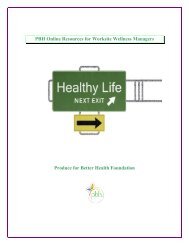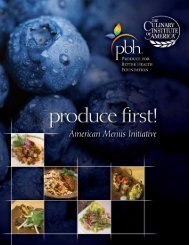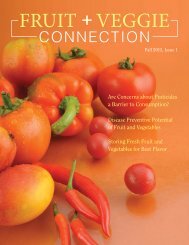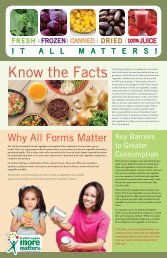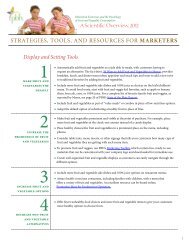anged from 30 percent to 120 percent <strong>for</strong> lettuce <strong>and</strong> green beans, respectively,while fruit price variation ranged from 26 to 140 percent betweenth lowest <strong>and</strong> highest priced markets <strong>for</strong> pears <strong>and</strong> watermelon. In overallcomparison with the national average, we found that on average fruits <strong>and</strong>vegetables were 20 percent lower in the least expensive market <strong>and</strong> 25 percenthigher in the most expensive market. For example, green bean prices were 38percent less than the national average in the lowest priced market, <strong>and</strong> watermelonswere 43 percent less than the national average price in their lowestmarket. Pepper prices, on the other h<strong>and</strong>, were 37 percent higher than thenational average price in their most expensive market, <strong>and</strong> orange prices were47 percent higher than the national average in their most expensive market.Some general patterns emerged with respect to which items <strong>and</strong> markets werecheaper or more expensive across the country. Peppers <strong>and</strong> tomatoes wereTable 2Market prices <strong>for</strong> the 20 most popular fruits <strong>and</strong> vegetables, with the deviation of their minimum <strong>and</strong>maximum prices from national average, 2004-2006<strong>Vegetable</strong>s<strong>and</strong> fruitsNational averageof market pricesper lbMinimummarket priceper lbMaximummarket priceper lbDifference fromminimum tomaximumDifference fromnational averageto minimumDifference fromnational averageto maximumDollarsPercentTomatoes 1.66 1.42 1.98 39 -15 19Onions 1.33 0.95 1.68 77 -29 26Lettuce 1.01 0.89 1.17 30 -11 16Green beans 0.96 0.59 1.31 12 -38 36Corn 0.89 0.74 1.11 50 -17 25Carrots 1.18 0.99 1.38 39 -16 17Broccoli 1.34 1.10 1.61 46 -18 20Cucumbers 1.02 0.81 1.33 64 -21 30Peppers 1.72 1.18 2.35 100 -32 37Cabbage 0.52 0.42 0.70 68 -20 34Bananas 0.49 0.40 0.62 55 -19 26Apples 1.10 0.98 1.24 27 -12 12Watermelon 0.87 0.49 1.19 140 -43 37Oranges 0.85 0.72 1.25 73 -15 47Grapes 1.51 1.31 1.70 30 -14 12Strawberries 2.41 2.15 2.86 33 -11 19Peaches 1.13 0.95 1.40 47 -15 25Pineapples 1.29 0.99 1.63 65 -23 26Pears 1.06 0.94 1.18 26 -11 12Grapefruit 0.98 0.78 1.24 60 -21 27Note: All minimum <strong>and</strong> maximum prices are signifi cantly different from the national average at the 5-percent level. Prices are in current dollars.Source: Authors’ calculations using Nielsen Homescan data.8<strong>The</strong> <strong>WIC</strong> <strong>Fruit</strong> <strong>and</strong> <strong>Vegetable</strong> <strong>Cash</strong> <strong>Voucher</strong>: Does Regional Price Variation Affect Buying Power? / EIB-75Economic Research Service/USDA
usually the most expensive per pound of the 10 most popular vegetables ineach of the 26 markets. Onions <strong>and</strong> broccoli were next, followed by carrots<strong>and</strong> then by cucumbers, lettuce, green beans, <strong>and</strong> corn, while cabbage was byfar the cheapest vegetable in all 26 markets. Among the 10 fruits analyzed,strawberries were by far the most expensive. Grapes were next, followed bypineapples, peaches, apples, pears, grapefruit, watermelon, <strong>and</strong> oranges, inroughly that order. Bananas were the cheapest fruit in all 26 markets. 12 (Seeappendix table A.2 <strong>for</strong> comparison of mean prices of different <strong>for</strong>ms of allvegetables <strong>and</strong> all fruits.)<strong>The</strong> lowest priced market was the Metro South 2 market group (Nashville,Birmingham, Memphis, <strong>and</strong> Louisville), followed by Metro Ohio (Cincinnati,Clevel<strong>and</strong>, <strong>and</strong> Columbus) <strong>and</strong> Salt Lake City. San Francisco had the highestprices, followed by Hart<strong>for</strong>d-New Haven <strong>and</strong> Washington, DC. Prices inthe Metro South 2 were 9.2 percent lower than the national average, whileprices in the highest priced market, San Francisco, were 13.9 percent higherthan the national average, a spread of 23.1 percentage points between theleast <strong>and</strong> most expensive markets. (See table 3 <strong>for</strong> a full list of rankings.)Other markets that fall in the bottom quintile of prices include the MetroSouth 3 market group (Little Rock, Oklahoma City, <strong>and</strong> Tulsa) <strong>and</strong> the MetroMountain market group (Denver <strong>and</strong> Phoenix). Additional markets in the topquintile with San Francisco include Baltimore <strong>and</strong> the South Florida marketgroup (Miami <strong>and</strong> Tampa). This index ranking, which is based on whatconsumers actually purchased, indicates that although participants may beable to substitute among certain fruits <strong>and</strong> vegetables, substantial price variationremains across markets.12 In this study, we calculate pricesbased on total pounds purchased. Thatis, we do not address the number ofservings or the portion of the fruits <strong>and</strong>vegetables that can be consumed. Foran analysis of this issue, see Stewart etal. (2011).Price Variation <strong>and</strong> <strong>WIC</strong><strong>The</strong> substantial price differences between markets imply that the same-valuevoucher allows <strong>WIC</strong> participants to purchase substantially different amountsof fruits <strong>and</strong> vegetables depending on where they live. Using data from 1999,the Committee to Review the <strong>WIC</strong> Food Packages (2006) estimated that withthe monthly $8 <strong>and</strong> $10 vouchers, participants would be able to purchase 10<strong>and</strong> 12 pounds of fresh fruits <strong>and</strong> vegetables per month, respectively, correspondingto roughly 1 or 2 servings a day. 13 When we examine the nationalaverage prices of the 20 most commonly purchased fruits <strong>and</strong> vegetablesbetween 2004-06, however, we find that participants would be unable tostretch their vouchers this far unless they purchased only the cheapest fruits<strong>and</strong> vegetables. 14 Participants in markets with prices higher than the nationalaverage will have an even more difficult time purchasing 10-12 pounds offruits <strong>and</strong> vegetables per month, while those buying in markets with lowerthan average prices may be able to purchase more fruits <strong>and</strong> vegetables thanthe amount recommended (table 4, discussed in detail below).Green beans display one of the most dramatic differences between thehighest <strong>and</strong> lowest priced markets. <strong>The</strong>y are 36 percent cheaper in the lowestpriced market (Metro South 3—Little Rock, Oklahoma City, <strong>and</strong> Tulsa) thanthe national average <strong>and</strong> 38 percent more expensive in the highest pricedmarket (San Francisco). This difference translates to 37 cents per pound lessin Little Rock, Oklahoma City, <strong>and</strong> Tulsa <strong>and</strong> 35 cents per pound more in SanFrancisco. While these differences may seem relatively small, the nationalaverage <strong>for</strong> 1 pound of green beans is 96 cents. With a fixed-value voucher13 As mentioned above, the committee’sreport also suggests that thevoucher be adjusted upward in Stateswhere local prices prevent participantsfrom purchasing this amount with the$8 <strong>and</strong> $10 vouchers the committeerecommends.14 Our results are based on theaverage prices <strong>for</strong> all <strong>for</strong>ms of fruits<strong>and</strong> vegetables (fresh, canned, <strong>and</strong>frozen) since the national guidelines <strong>for</strong>the voucher allow all <strong>for</strong>ms. For mostof the items we examined, the cannedversion is the cheapest, followed byfresh r<strong>and</strong>om weight, then frozen, <strong>and</strong>finally UPC fresh items (see appendix.table 2).<strong>The</strong>re<strong>for</strong>e, the mean market price ofonly fresh items is the same or higher<strong>for</strong> all items (except onions) whencanned <strong>and</strong> frozen prices are excluded.9<strong>The</strong> <strong>WIC</strong> <strong>Fruit</strong> <strong>and</strong> <strong>Vegetable</strong> <strong>Cash</strong> <strong>Voucher</strong>: Does Regional Price Variation Affect Buying Power? / EIB-75Economic Research Service/USDA



